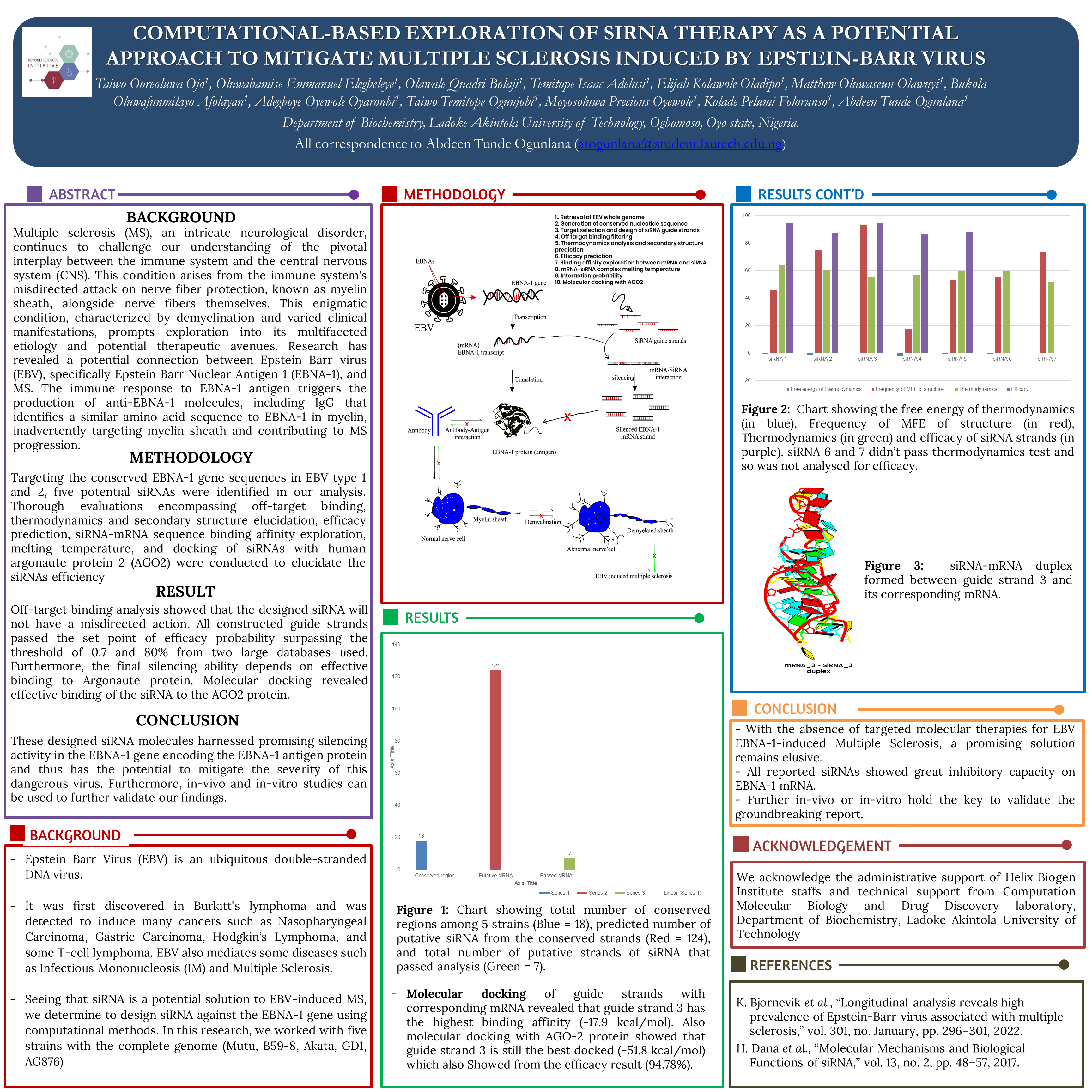Taiwo Ojo
Conference 2024 Poster
Poster Title
Computational-based exploration of siRNA therapy as a potential approach to mitigate multiple sclerosis induced by Epstein-Barr Virus
Authors and Affiliations
Taiwo Ooreoluwa Ojo1,2*, Oluwabamise Emmanuel Elegbeleye3, Olawale Quadri Bolaji1, Temitope Isaac Adelusi1, Elijah Kolawole Oladipo2,4, Matthew Oluwaseun Olawuyi1, Oluwabukola Oluwafunmilayo Afolayan1, Adegboye Oyewole Oyaronbi5, Taiwo Temitope Ogunjobi5, Moyosoluwa Precious Oyewole6, Kolade Pelumi Folorunso7, Abdeen Tunde Ogunlana8
1. Computational Molecular Biology and Drug Discovery Laboratory, Department of Biochemistry, Ladoke Akintola University of Technology, Ogbomoso, Oyo State. Nigeria
2. Genomics unit, Helix Biogen Institute, Ogbomoso, Oyo State, Nigeria
3. Department of Biochemistry, Havarde College of Science, Business and Management, Obada, Ogun State, Nigeria
4. Laboratory of Molecular Biology, Bioinformatics and Immunology, Department of Microbiology, Adeleke University, Ede, Osun State, Nigeria
5. Department of Biochemistry, Ladoke Akintola University of Technology, Ogbomoso, Oyo State, Nigeria
6. Biochemistry program, Bowen University, Iwo, Osun State, Nigeria
7. Department of Anatomy, Ladoke Akintola University of Technology, Ogbomoso, Oyo State, Nigeria
8. Institute for Advanced Medical Research and Training, College of Medicine, University of Ibadan, Ibadan, Oyo State, Nigeria
Abstract
Background
Multiple sclerosis (MS), an intricate neurological disorder, continues to challenge our understanding of the pivotal interplay between the immune system and the central nervous system (CNS). This condition arises from the immune system’s misdirected attack on nerve fiber protection, known as myelin sheath, alongside nerve fibers themselves. This enigmatic condition, characterized by demyelination and varied clinical manifestations, prompts exploration into its multifaceted etiology and potential therapeutic avenues. Research has revealed a potential connection between Epstein Barr virus (EBV), specifically Epstein Barr Nuclear Antigen 1 (EBNA-1), and MS. The immune response to EBNA-1 antigen triggers the production of anti-EBNA-1 molecules, including IgG that identifies a similar amino acid sequence to EBNA-1 in myelin, inadvertently targeting myelin sheath and contributing to MS progression. . Currently, no treatment exists for EBNA-1-induced MS apart from symptom management. Addressing this, a novel Potential therapeutic avenue utilizing small interference RNAs (siRNA) has been designed.
Methods
By targeting the conserved EBNA-1 gene sequences in EBV type 1 and 2, five potential siRNAs were identified in our analysis. Thorough evaluations encompassing off-target binding, thermodynamics and secondary structure elucidation, efficacy prediction, siRNA-mRNA sequence binding affinity exploration, melting temperature, and docking of siRNAs with human argonaute protein 2 (AGO2) were conducted to elucidate the siRNAs efficiency.
Results
Off-target binding analysis showed that the designed siRNA will not have a misdirected action. All constructed guide strands passed the set point of efficacy probability surpassing the threshold of 0.7 and 80% from two large database used. Furthermore, final silencing ability depends on effective binding to Argonaute protein. Molecular docking revealed effective binding of the siRNA to AGO2 protein.
Conclusions
These designed siRNA molecules harnessed promising silencing activity in the EBNA-1 gene encoding the EBNA-1 antigen protein and thus has the potential to mitigate the severity of this dangerous virus. Furthermore, in-vivo and in-vitro studies can be used to further validate our findings.


Leave A Comment